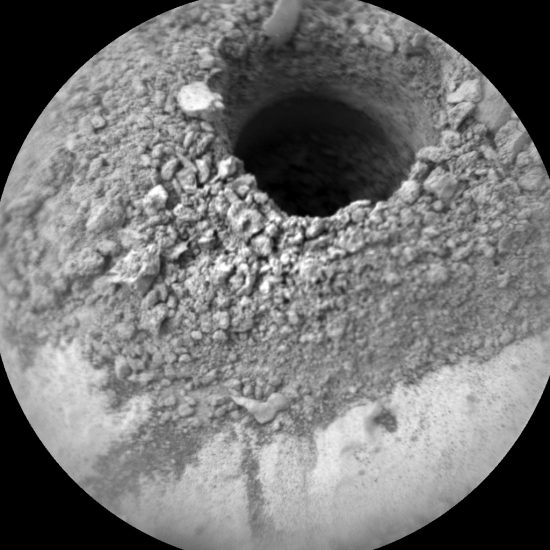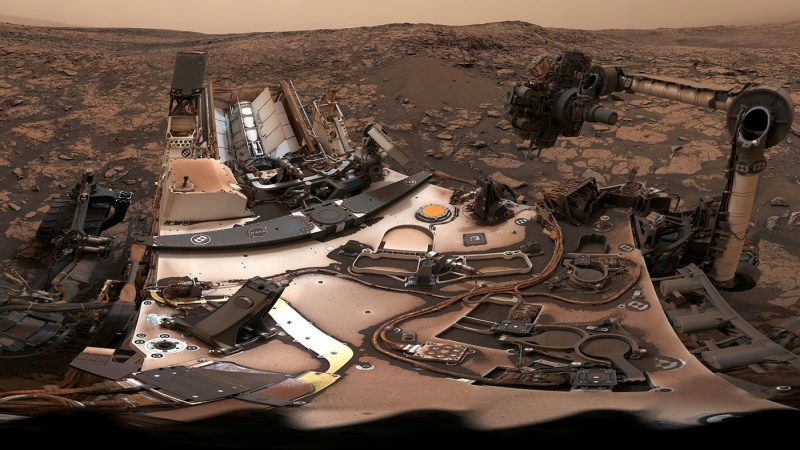
Mars is coming up on its perihelion, or closest point to the sun, on September 16, and, as often happens when Mars draws closest to its source of light and heat, a global dust storm has been raging for several months on the Red Planet. The dust storm began in May, 2018, and went global in June, blotting out the sun from Mars surface and cutting off signals from NASA’s Opportunity rover, which still sits silent on Mars surface. Meanwhile, though, the dust storm has abated, and now NASA has released a new 360-degree panorama from its Curiosity rover, made with images acquired in August, shown in the interactive video above.
Isn’t it great?! Take a minute to explore the video, and you will see clouds of dust still hanging in the martian air, off in the distance, as well as dust on the surface of the rover itself.

View larger. | NASA’s Curiosity rover acquired the images to create this 360-degree panorama at its location on Vera Rubin Ridge on August 9, 2018. Image via NASA/JPL-Caltech/MSSS.
The Curiosity rover also snagged a new rock sample on August 9. The drilling site is pictured below:

It took 3 attempts for the Curiosity rover on Mars to drill this hole on the Vera Rubin Ridge, but it succeeded on August 9, 2018. Scientists crowed: “Curiosity has successfully drilled, and generated a pile of drill tailings.” Read more about this image.
NASA said the new drill sample “delighted” Curiosity’s science team, because:
… the rover’s last two drill attempts were thwarted by unexpectedly hard rocks. Curiosity started using a new drill method earlier this year to work around a mechanical problem. Testing has shown it to be as effective at drilling rocks as the old method, suggesting the hard rocks would have posed a problem no matter which method was used.
After the drilling, the rover stopped to survey its surroundings on Mars – producing the 360-degree panorama featured in the video above and photos below. NASA said:
The panorama includes umber skies, darkened by a fading global dust storm. It also includes a rare view by the Mast Camera of the rover itself, revealing a thin layer of dust on Curiosity’s deck. In the foreground is the rover’s most recent drill target, named ‘Stoer’ after a town in Scotland near where important discoveries about early life on Earth were made in lakebed sediments.
That’s some optimistic thinking indeed from Curiosity’s science team!
Read more about what Curiosity is doing, via NASA

Close-up from the August, 2018, panorama of Mars, made by the Curiosity rover. See the dust on the rover’s surface? Image via NASA/JPL-Caltech/MSSS.
Bottom line: An August, 2018, 360-degree panorama from NASA’s Curiosity rover. Notice the dust!
from EarthSky https://ift.tt/2N1m8LC

Mars is coming up on its perihelion, or closest point to the sun, on September 16, and, as often happens when Mars draws closest to its source of light and heat, a global dust storm has been raging for several months on the Red Planet. The dust storm began in May, 2018, and went global in June, blotting out the sun from Mars surface and cutting off signals from NASA’s Opportunity rover, which still sits silent on Mars surface. Meanwhile, though, the dust storm has abated, and now NASA has released a new 360-degree panorama from its Curiosity rover, made with images acquired in August, shown in the interactive video above.
Isn’t it great?! Take a minute to explore the video, and you will see clouds of dust still hanging in the martian air, off in the distance, as well as dust on the surface of the rover itself.

View larger. | NASA’s Curiosity rover acquired the images to create this 360-degree panorama at its location on Vera Rubin Ridge on August 9, 2018. Image via NASA/JPL-Caltech/MSSS.
The Curiosity rover also snagged a new rock sample on August 9. The drilling site is pictured below:

It took 3 attempts for the Curiosity rover on Mars to drill this hole on the Vera Rubin Ridge, but it succeeded on August 9, 2018. Scientists crowed: “Curiosity has successfully drilled, and generated a pile of drill tailings.” Read more about this image.
NASA said the new drill sample “delighted” Curiosity’s science team, because:
… the rover’s last two drill attempts were thwarted by unexpectedly hard rocks. Curiosity started using a new drill method earlier this year to work around a mechanical problem. Testing has shown it to be as effective at drilling rocks as the old method, suggesting the hard rocks would have posed a problem no matter which method was used.
After the drilling, the rover stopped to survey its surroundings on Mars – producing the 360-degree panorama featured in the video above and photos below. NASA said:
The panorama includes umber skies, darkened by a fading global dust storm. It also includes a rare view by the Mast Camera of the rover itself, revealing a thin layer of dust on Curiosity’s deck. In the foreground is the rover’s most recent drill target, named ‘Stoer’ after a town in Scotland near where important discoveries about early life on Earth were made in lakebed sediments.
That’s some optimistic thinking indeed from Curiosity’s science team!
Read more about what Curiosity is doing, via NASA

Close-up from the August, 2018, panorama of Mars, made by the Curiosity rover. See the dust on the rover’s surface? Image via NASA/JPL-Caltech/MSSS.
Bottom line: An August, 2018, 360-degree panorama from NASA’s Curiosity rover. Notice the dust!
from EarthSky https://ift.tt/2N1m8LC

Aucun commentaire:
Enregistrer un commentaire